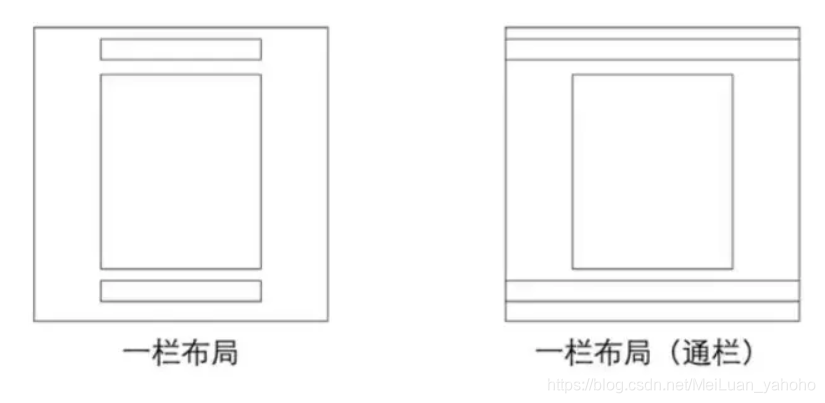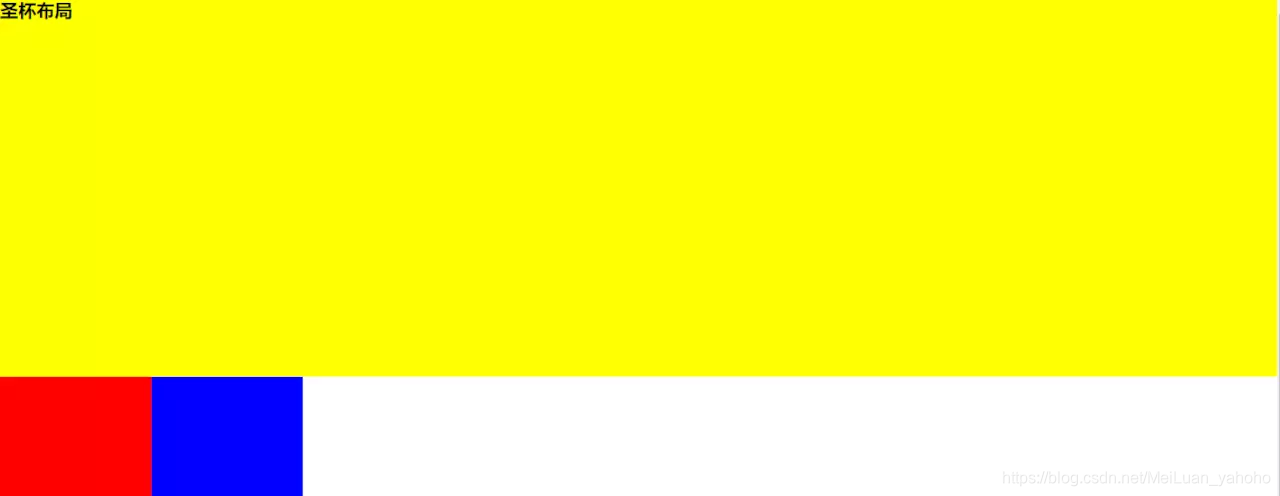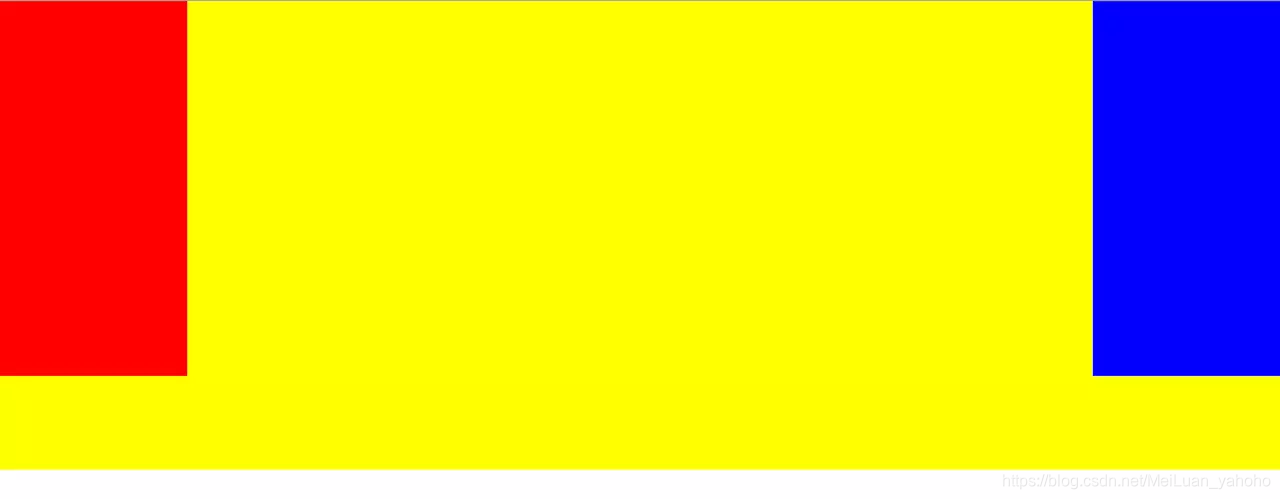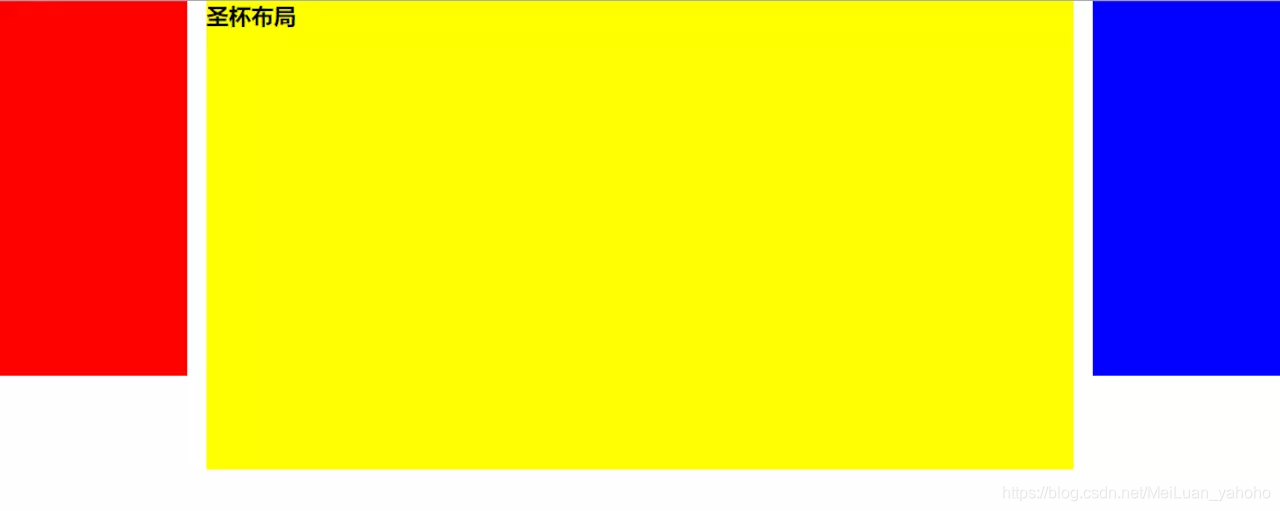单列布局

常见的单列布局有两种:
- header,content和footer等宽的单列布局
- header与footer等宽,content略窄的单列布局
1.如何实现
对于第一种,先通过对header,content,footer统一设置width:1000px;或者max-width:1000px(这两者的区别是当屏幕小于1000px时,前者会出现滚动条,后者则不会,显示出实际宽度);然后设置margin:auto实现居中即可得到。
<div class="header"></div>
<div class="content"></div>
<div class="footer"></div>
.header{
margin:0 auto;
max-width: 960px;
height:100px;
background-color: blue;
}
.content{
margin: 0 auto;
max-width: 960px;
height: 400px;
background-color: aquamarine;
}
.footer{
margin: 0 auto;
max-width: 960px;
height: 100px;
background-color: aqua;
}
对于第二种,header、footer的内容宽度不设置,块级元素充满整个屏幕,但header、content和footer的内容区设置同一个width,并通过margin:auto实现居中。
<div class="header">
<div class="nav"></div>
</div>
<div class="content"></div>
<div class="footer"></div>
.header{
margin:0 auto;
max-width: 960px;
height:100px;
background-color: blue;
}
.nav{
margin: 0 auto;
max-width: 800px;
background-color: darkgray;
height: 50px;
}
.content{
margin: 0 auto;
max-width: 800px;
height: 400px;
background-color: aquamarine;
}
.footer{
margin: 0 auto;
max-width: 960px;
height: 100px;
background-color: aqua;
}
二、两列自适应布局
两列自适应布局是指一列由内容撑开,另一列撑满剩余宽度的布局方式
1.float+overflow:hidden
如果是普通的两列布局,浮动+普通元素的margin便可以实现,但如果是自适应的两列布局,利用float+overflow:hidden便可以实现,这种办法主要通过overflow触发BFC,而BFC不会重叠浮动元素。由于设置overflow:hidden并不会触发IE6-浏览器的haslayout属性,所以需要设置zoom:1来兼容IE6-浏览器。具体代码如下:
<div class="parent" style="background-color: lightgrey;">
<div class="left" style="background-color: lightblue;">
<p>left</p>
</div>
<div class="right" style="background-color: lightgreen;">
<p>right</p>
<p>right</p>
</div>
</div>
.parent {
overflow: hidden;
zoom: 1;
}
.left {
float: left;
margin-right: 20px;
}
.right {
overflow: hidden;
zoom: 1;
}
注意点:如果侧边栏在右边时,注意渲染顺序。即在HTML中,先写侧边栏后写主内容
2.Flex布局
Flex布局,也叫弹性盒子布局,区区简单几行代码就可以实现各种页面的的布局。
//html部分同上
.parent {
display:flex;
}
.right {
margin-left:20px;
flex:1;
}
3.grid布局
//html部分同上
.parent {
display:grid;
grid-template-columns:auto 1fr;
grid-gap:20px
}
三、三栏布局
特征:中间列自适应宽度,旁边两侧固定宽度
1.圣杯布局
① 特点
比较特殊的三栏布局,同样也是两边固定宽度,中间自适应,唯一区别是dom结构必须是先写中间列部分,这样实现中间列可以优先加载。
.container {
padding-left: 220px;//为左右栏腾出空间
padding-right: 220px;
}
.left {
float: left;
width: 200px;
height: 400px;
background: red;
margin-left: -100%;
position: relative;
left: -220px;
}
.center {
float: left;
width: 100%;
height: 500px;
background: yellow;
}
.right {
float: left;
width: 200px;
height: 400px;
background: blue;
margin-left: -200px;
position: relative;
right: -220px;
}
<article class="container">
<div class="center">
<h2>圣杯布局</h2>
</div>
<div class="left"></div>
<div class="right"></div>
</article>
② 实现步骤
- 三个部分都设定为左浮动,否则左右两边内容上不去,就不可能与中间列同一行。然后设置center的宽度为100%(实现中间列内容自适应),此时,left和right部分会跳到下一行

- 通过设置margin-left为负值让left和right部分回到与center部分同一行

- 通过设置相对定位,让left和right部分移动到两边。

③ 缺点 - center部分的最小宽度不能小于left部分的宽度,否则会left部分掉到下一行
- 如果其中一列内容高度拉长(如下图),其他两列的背景并不会自动填充。(借助等高布局正padding+负margin可解决,下文会介绍)

2.双飞翼布局
① 特点
同样也是三栏布局,在圣杯布局基础上进一步优化,解决了圣杯布局错乱问题,实现了内容与布局的分离。而且任何一栏都可以是最高栏,不会出问题。
.container {
min-width: 600px;//确保中间内容可以显示出来,两倍left宽+right宽
}
.left {
float: left;
width: 200px;
height: 400px;
background: red;
margin-left: -100%;
}
.center {
float: left;
width: 100%;
height: 500px;
background: yellow;
}
.center .inner {
margin: 0 200px; //新增部分
}
.right {
float: left;
width: 200px;
height: 400px;
background: blue;
margin-left: -200px;
}
<article class="container">
<div class="center">
<div class="inner">双飞翼布局</div>
</div>
<div class="left"></div>
<div class="right"></div>
</article>
② 实现步骤(前两步与圣杯布局一样)
三个部分都设定为左浮动,然后设置center的宽度为100%,此时,left和right部分会跳到下一行;
通过设置margin-left为负值让left和right部分回到与center部分同一行;
center部分增加一个内层div,并设margin: 0 200px;
③ 缺点
多加一层 dom 树节点,增加渲染树生成的计算量。










 本文深入讲解了网页布局的多种技巧,包括单列、两列自适应及三栏布局的实现方法,如圣杯布局和双飞翼布局。通过实例代码详细解析了不同布局的优缺点。
本文深入讲解了网页布局的多种技巧,包括单列、两列自适应及三栏布局的实现方法,如圣杯布局和双飞翼布局。通过实例代码详细解析了不同布局的优缺点。
















 1640
1640

 被折叠的 条评论
为什么被折叠?
被折叠的 条评论
为什么被折叠?








